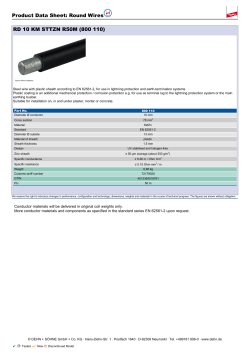
see Manual
Electro Magnetic Theory VIRTUAL LABS Manual for Electric Field in Material Space Electro Magnetic Theory Introduction: Just as electric fields can exist in free space, they can exist in material media. Materials are broadly classified in terms of their electrical properties as conductors, semiconductors and insulators. Non-conducting materials are usually referred to as insulators or dielectrics. A conductor is a material which contains movable electric charges. Metals such as copper aluminium are examples of conductors. In a Conductor the outer electrons of the atoms are loosely bound and free to move through the material. In conductors, the valence electrons are essentially free and strongly repel each other. Any external influence which moves one of them will cause a repulsion of other electrons which propagates through the conductor. In an insulator the free electric charges are very few in number. Most solid materials are classified as insulators because they offer very large resistance to the flow of electric current. In insulators the outermost electrons are so tightly bound that there is essentially zero electron flow through them with ordinary voltages. The properties of semiconductors lie in between conductors and insulators. Here we examine the electric field inside a conductor and an insulator. Objectives: The main objectives of this experiment are the following: 1. To measure the electric field inside a conductor. 2. To measure the polarization and electric fields at various distances inside a dielectric due to a charge placed at center. Theory: 1. Conductors A conductor has abundant free charges to move. When an external electric field E is applied to an isolated conductor, the positive free charges move in the direction of the applied field, while the negative free charges move in the opposite direction. These charges get accumulated on the surface of the conductor and set up an internal field Einduced which is equal and opposite in direction to the applied external E field. Thus net field in the conductor is zero. Electro Magnetic Theory Enet = E + Einduced= 0. Applying Gauss' law inside the conductor, as electric field is zero that implies there is no net charge inside the conductor. Inside the conductor, the electric field and the volume density of charge are zero, i.e. The charge remains only on the outer surface of a conductor. E=0 hence ρ, where ρ is charge density. The above equation is first of the Maxwell's four equations, in differential form. As you know that electric potential is the amount of work done in moving the unit charge from point A to point B in an electric field, the potential required in moving a charge inside the conductor is zero as the electric field inside it is zero. Hence we can consider that a conductor is equipotential body which means that potential is same everywhere in the conductor. 2. Dielectrics and Polarization Now you know that dielectric contains very few free electrons. The electrons are bound by the forces within the material. When a dielectric is placed in electric field although the charges cannot move freely they tend to displace from their original path. The above picture depicts that, at atom level, when electric field is applied the electrons tend to spend more time away from the electric field, thereby we would observe a dipole like behaviour of the atom. This is called as polarization and the atoms acquire an electric dipole moment. If molecules of the dielectric are polar in nature then the polarization Electro Magnetic Theory effect would be significant. As shown if the above figure as molecules act like dipoles their dipole moment is defined as charge times the distance vector seperating the positive and negative charges. Polarization is defined as the dipole moment per unit volume of the dielectric: When a dielectric is placed in electric field a surface charge density equivalent to volume charge, that is created due to polarization of dielectric, is formed. Both charge densities are such that they cancel each other and hence dielectric remains neutral. Polarization of dielectric is proportional to the applied electric field and is given by where ε0 is the permittivity of free space, and χe is the electric susceptibility of the medium. Dielectric constant or relative permittivity εr of a material is defined as Electro Magnetic Theory where ε is the permittivity of the dielectric and ε0 is the permittivity of free space. If a free charge is placed in a dielectric region then the elecrtic flux density would increase by the amount of Polarization and is given by: D = εo;E + P = &epsilonE Dielectric materials are placed in between capacitor plates to increase the capacitance. Procedure: This experiment consists of two stages and each stage will teach you a new concept. The experiment was designed in a way, so that you can quickly change the parameters and observe the results. This makes you to have a more clear picture of the concepts. Start the experiment by pressing start button • STAGE 1: 1. This stage deals with electric field inside a conductor. You can observe the electric field at point by using mouse clicks. 2. You can vary external electric field by using slider provided at the bottom of the window and observe the change in the electric field inside the conductor. 3. To move on to next stage press next button on the top of window. • STAGE 2: 1. Remember that as electric fields can exist in free space, they can exist in material media. 2. Now, we deal with electric field inside a insulator. Note that in an insulator the free electric charges are very few in number. 3. Measure the electric field inside and outside the dielectric by varying the parameters charge, radius, and relative permittivity.
© Copyright 2025











